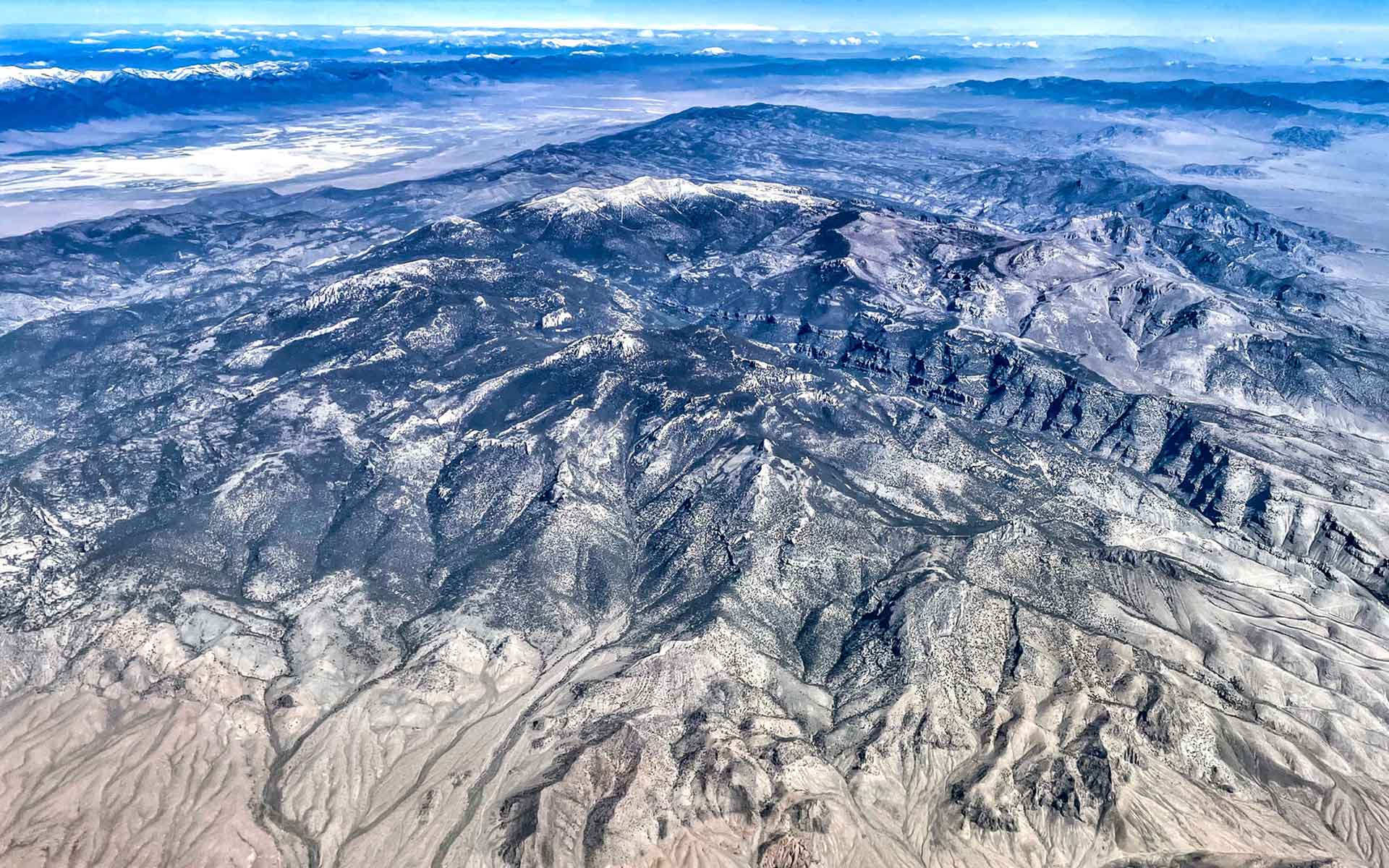
View north of the Northern Snake Range. Stretched lower plate quartzite and schist units (subhoriontal) visible in Hendry’s Creek, SE flank of the Range. High peak is Mt. Moriah. (photo credit, Michael McWilliams).
Geological Period
Cenozoic, Oligocene to Miocene
Main geological interest
Tectonics
Location
East Central Nevada, USA.
39°12’30.0″N, 114°04’33.0″W
View north of the Northern Snake Range. Stretched lower plate quartzite and schist units (subhoriontal) visible in Hendry’s Creek, SE flank of the Range. High peak is Mt. Moriah. (photo credit, Michael McWilliams).
A cenozoic extensional metamorphic core complex where Neoproterozoic-lower Paleozoic strata are tectonically thinned to as much as ~10% of their original thicknesses.
The definition of mylonites was closely linked to their discovery and study in extensional metamorphic core complexes of the Cordillera. The Northern Snake Range is distinguished from other metamorphic core complexes because of its remarkable stratigraphy of units in both upper and lower plates allowing for semi-quantitative measures of strain (Miller et al., 1983). Lower plate rocks record an extraordinary strain gradient from ~165% to ~ 650% extension from west to east with an associated progression in quartz micro- and mesoscopic structures and petrofabrics from pure to simple shear deformation (see cross-section) (Lee et al., 1987; 2017).
- Geological description
Metamorphic core complexes and their detachment faults were enigmatic structures interpreted in pre-plate tectonic times as basal detachments for gravitationally driven thrust faults exposed to the east in the Mesozoic Sevier fold-thrust belt. Recognition that Cenozoic rocks were involved in detachment faulting in the 1970s was key to their interpretation as younger extensional fault systems.
Rock units near Hendry’s Creek in the Northern Snake Range include Precambrian to Cambrian quartzite and schist (lower plate) and highly faulted Cambrian to Permian strata in an upper plate position above the Snake Range detachment (SRD) (cross-section below). Ductile deformation produced flaggy lineated quartz mylonites in the lower plate (photo above); this deformation is kinematically coordinated to upper plate extension by faulting (Miller et al., 1983; Lee et al., 1987). U-Pb zircon ages of dikes bracket lower plate strain to between late Eocene and early Miocene (Lee et al., 2017). Miocene strata are cut and tilted by upper plate faults along the flanks of the range (Miller et al., 1999) and apatite fission track data indicate likely continued mylonitization and rapid cooling of lower plate rocks to near surface conditions in the Miocene, ca. 15-17 Ma (Miller et al., 1999).
- Scientific research and tradition
The Northern Snake Range provides a natural laboratory for modern studies on the tectonic processes that form metamorphic core complexes and the deformational processes that form mylonites. Geologic mapping and work to date has provided the foundation for decades of continuing research and teaching efforts; yet many unresolved questions remain.
- Reference
Lee, J., Blackburn, T. and Johnston, S. (2017) ‘Timing of mid-crustal ductile extension in the northern Snake Range metamorphic core complex, Nevada: Evidence from U/Pb zircon ages’, Geosphere, 13(2), pp. 439–459. Available at: https://doi.org/10.1130/GES01429.1.
Lee, J., Miller, E.L. and Sutter, J.F. (1987) ‘Ductile strain and metamorphism in an extensional tectonic setting: a case study from the northern Snake Range, Nevada, USA’, Geological Society of London Special Publications, 28, pp. 267–298. Available at: https://doi.org/10.1144/GSL.SP.1987.028.01.18.
Miller, E.L. et al. (1999) ‘Rapid Miocene slip on the Snake Range–Deep Creek Range fault system, east-central Nevada’, GSA Bulletin, 111(6), pp. 886–905. Available at: https://doi.org/10.1130/0016-7606(1999)111<0886:RMSOTS>2.3.CO;2.
Miller, E.L., Gans, P.B. and Garing, J. (1983) ‘The Snake Range Décollement: An exhumed Mid-Tertiary ductile-brittle transition’, Tectonics, 2(3), pp. 239–263. Available at: https://doi.org/10.1029/TC002i003p00239.
Miller, E.L., Gans, P.B. and Lee, J. (1987) ‘The Snake Range decollement, eastern Nevada’, in Cordilleran Section, Geological Society of America Centennial Field Guide Vol. 1. Hill, M.L., ed, pp. 77–82.
- Author(s)
Elizabeth L. Miller
Department of Geological Sciences, Stanford University, Stanford CA 94305 USA
Jeffrey Lee
Department of Geophysics, Colorado School of Mines, Golden, CO 8040, USA


